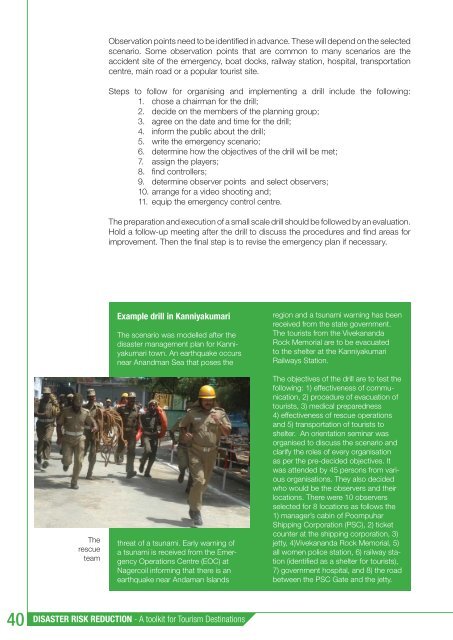Disaster Risk Reduction - A Toolkit for Tourism ... - PreventionWeb
Disaster Risk Reduction - A Toolkit for Tourism ... - PreventionWeb
Disaster Risk Reduction - A Toolkit for Tourism ... - PreventionWeb
You also want an ePaper? Increase the reach of your titles
YUMPU automatically turns print PDFs into web optimized ePapers that Google loves.
Observation points need to be identifi ed in advance. These will depend on the selected<br />
scenario. Some observation points that are common to many scenarios are the<br />
accident site of the emergency, boat docks, railway station, hospital, transportation<br />
centre, main road or a popular tourist site.<br />
Steps to follow <strong>for</strong> organising and implementing a drill include the following:<br />
1. chose a chairman <strong>for</strong> the drill;<br />
2. decide on the members of the planning group;<br />
3. agree on the date and time <strong>for</strong> the drill;<br />
4. in<strong>for</strong>m the public about the drill;<br />
5. write the emergency scenario;<br />
6. determine how the objectives of the drill will be met;<br />
7. assign the players;<br />
8. fi nd controllers ;<br />
9. determine observer points and select observers;<br />
10. arrange <strong>for</strong> a video shooting and;<br />
11. equip the emergency control centre.<br />
The preparation and execution of a small scale drill should be followed by an evaluation.<br />
Hold a follow-up meeting after the drill to discuss the procedures and fi nd areas <strong>for</strong><br />
improvement. Then the fi nal step is to revise the emergency plan if necessary.<br />
The<br />
rescue<br />
team<br />
Example drill in Kanniyakumari<br />
The scenario was modelled after the<br />
disaster management plan <strong>for</strong> Kanniyakumari<br />
town. An earthquake occurs<br />
near Anandman Sea that poses the<br />
threat of a tsunami. Early warning of<br />
a tsunami is received from the Emergency<br />
Operations Centre (EOC) at<br />
Nagercoil in<strong>for</strong>ming that there is an<br />
earthquake near Andaman Islands<br />
region and a tsunami warning has been<br />
received from the state government.<br />
The tourists from the Vivekananda<br />
Rock Memorial are to be evacuated<br />
to the shelter at the Kanniyakumari<br />
Railways Station.<br />
The objectives of the drill are to test the<br />
following: 1) effectiveness of communication,<br />
2) procedure of evacuation of<br />
tourists, 3) medical preparedness<br />
4) effectiveness of rescue operations<br />
and 5) transportation of tourists to<br />
shelter. An orientation seminar was<br />
organised to discuss the scenario and<br />
clarify the roles of every organisation<br />
as per the pre-decided objectives. It<br />
was attended by 45 persons from various<br />
organisations. They also decided<br />
who would be the observers and their<br />
locations. There were 10 observers<br />
selected <strong>for</strong> 8 locations as follows the<br />
1) manager’s cabin of Poompuhar<br />
Shipping Corporation (PSC), 2) ticket<br />
counter at the shipping corporation, 3)<br />
jetty, 4)Vivekananda Rock Memorial, 5)<br />
all women police station, 6) railway station<br />
(identifi ed as a shelter <strong>for</strong> tourists),<br />
7) government hospital, and 8) the road<br />
between the PSC Gate and the jetty.<br />
40<br />
DISASTER RISK REDUCTION - A toolkit <strong>for</strong> <strong>Tourism</strong> Destinations

















